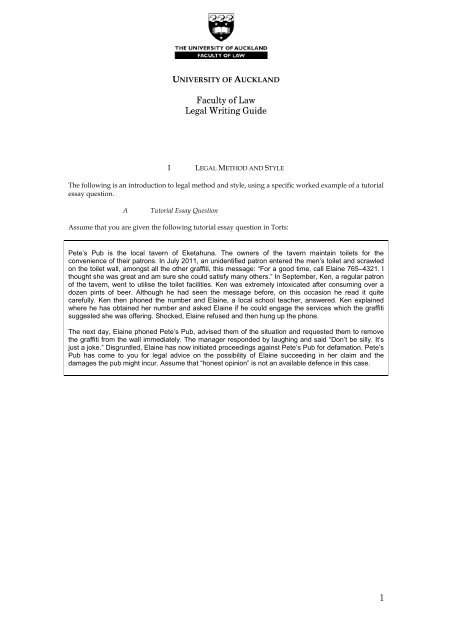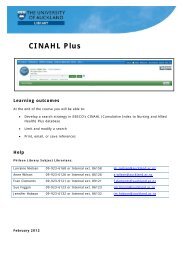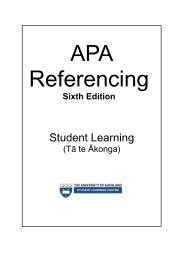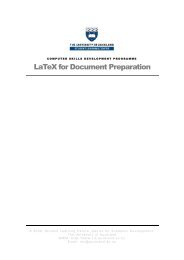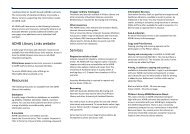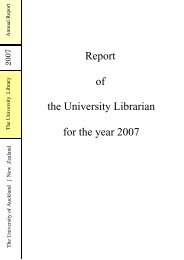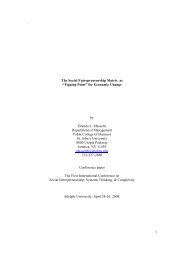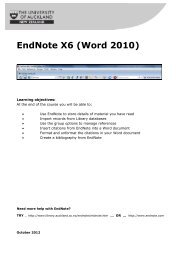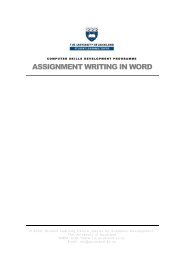Legal Writing Guide - The University of Auckland Library
Legal Writing Guide - The University of Auckland Library
Legal Writing Guide - The University of Auckland Library
You also want an ePaper? Increase the reach of your titles
YUMPU automatically turns print PDFs into web optimized ePapers that Google loves.
UNIVERSITY OF AUCKLANDFaculty <strong>of</strong> Law<strong>Legal</strong> <strong>Writing</strong> <strong>Guide</strong>ILEGAL METHOD AND STYLE<strong>The</strong> following is an introduction to legal method and style, using a specific worked example <strong>of</strong> a tutorialessay question.ATutorial Essay QuestionAssume that you are given the following tutorial essay question in Torts:Pete’s Pub is the local tavern <strong>of</strong> Eketahuna. <strong>The</strong> owners <strong>of</strong> the tavern maintain toilets for theconvenience <strong>of</strong> their patrons. In July 2011, an unidentified patron entered the men’s toilet and scrawledon the toilet wall, amongst all the other graffiti, this message: “For a good time, call Elaine 765–4321. Ithought she was great and am sure she could satisfy many others.” In September, Ken, a regular patron<strong>of</strong> the tavern, went to utilise the toilet facilities. Ken was extremely intoxicated after consuming over adozen pints <strong>of</strong> beer. Although he had seen the message before, on this occasion he read it quitecarefully. Ken then phoned the number and Elaine, a local school teacher, answered. Ken explainedwhere he has obtained her number and asked Elaine if he could engage the services which the graffitisuggested she was <strong>of</strong>fering. Shocked, Elaine refused and then hung up the phone.<strong>The</strong> next day, Elaine phoned Pete’s Pub, advised them <strong>of</strong> the situation and requested them to removethe graffiti from the wall immediately. <strong>The</strong> manager responded by laughing and said “Don’t be silly. It’sjust a joke.” Disgruntled, Elaine has now initiated proceedings against Pete’s Pub for defamation. Pete’sPub has come to you for legal advice on the possibility <strong>of</strong> Elaine succeeding in her claim and thedamages the pub might incur. Assume that “honest opinion” is not an available defence in this case.1
B<strong>The</strong> Research Process1 Know thy library!It is simply not possible to conduct legal research efficiently and effectively unless you know how toaccess legal information.<strong>The</strong> home page <strong>of</strong> the Davis Law <strong>Library</strong> at the <strong>University</strong> <strong>of</strong> <strong>Auckland</strong>,http://www.library.auckland.ac.nz/subject-guides/law/home.htm (at 21 April 2012), providesdetailed information on:<strong>The</strong> collection in the Davis Law <strong>Library</strong>. <strong>The</strong> collection uses the Moys classification system.Information sheets listing the classification numbers and book locations are available both at theInformation Desk in the Davis Law <strong>Library</strong> and online. <strong>The</strong>re is also signage on the shelves to assistin locating reclassified sources.<strong>The</strong> legal resources, particularly online resources, which are available in the Davis Law <strong>Library</strong>.<strong>The</strong>se are grouped into:‣ New Zealand legal resources (cases, legislation, commentaries and encyclopaedias, journalarticles, internet resources): (at 27April 2012)‣ Law journal articles (indexing databases, full text online journals): (at 27April 2012)‣ Other jurisdictions (Australia, Asia-Pacific, Canada, EU, UN, USA, UK): (at 27April 2012)‣ Online legal references (encyclopaedias, dictionaries, legal abbreviations, citation/styleguides):(at 27 April 2012)‣ Databases and course guides (Voyager, databases, course guides): (at 27 April2012)‣ Area <strong>of</strong> law by topic: (at 27April 2012)2 Preliminary readingRead the question through several times very carefully. Ask yourself: “what exactly am I being requiredto do?” Often this is explicitly stated at the end <strong>of</strong> the question, as is the case here. You are being askedto advise Pete’s Pub on the merits <strong>of</strong> Elaine’s defamation claim and the damages that might be awarded.You are not being asked to address other causes <strong>of</strong> action such as negligence, malicious falsehood,invasion <strong>of</strong> privacy or intentional infliction <strong>of</strong> emotional distress. Confine your research accordingly.Note also the final sentence <strong>of</strong> the problem. You are told not to consider the defence <strong>of</strong> honest opinionfor the purposes <strong>of</strong> this essay. Do not research this issue or discuss it. Too <strong>of</strong>ten students miss such vitalinformation in a question and waste valuable time researching and writing about something for whichthey will be given no credit.In sum, read the question very carefully, follow instructions closely, and focus only on what thequestion requires.2
3 Identify the relevant factsHighlight and separate out the material facts that you think will be relevant to the legal issues. If you donot do so, you may overlook an important fact, or focus your research on a less relevant set <strong>of</strong> facts.Separating out the relevant facts helps to ensure that your research and analysis is more structured,streamlined and efficient.Analyze the facts meticulously and objectively. Do not generate any extra facts, or re-interpret or “shoehorn”the facts into your particular view <strong>of</strong> the case.If there are facts that might have been relevant or useful but are not mentioned in the question, youshould assume that you are not expected to address that particular issue at length (or at all).However, if you believe that you have not been given facts in the question that are crucial to a centrallegal issue which must be resolved, identify the additional information you require and how it wouldaffect your legal opinion.Here, the material facts might be:Message: “For a good time, call Elaine 765–4321. I thought she was great and am sure she couldsatisfy many others.”Written on toilet wall by unknown patron (not by Pete’s Pub employees).Message acted on by extremely drunk patron <strong>of</strong> Pete’s Pub.Pete’s Pub treats it as a joke and refuses to remove the message.4 Identify the legal issuesDepending on the level <strong>of</strong> your existing knowledge and the question, you may already be able toidentify the main issues and prioritize them on a preliminary basis, based on how significantly theyaffect the answer to the question. Be careful, however, not to treat this preliminary analysis as set instone — you should always reassess your preliminary view <strong>of</strong> the issues once you have completed moreresearch.If you are not at all sure what the legal issue is and the question does not provide any clues, try toextract relevant legal concepts or keywords from the material facts — tort, false statement, reputation,innuendo, privacy, hurt feelings etc. <strong>The</strong>n check the index and table <strong>of</strong> contents <strong>of</strong> the leading textbooksin the area to see if you can identify the relevant legal issues and narrow down your field <strong>of</strong> enquiry.Alternatively, using your keywords, run a subject or full text search in the relevant text/commentaries,legal periodicals and case databases, to see if you can identify relevant texts, commentaries, journalarticles or cases that are relevant to the question.5 Research!Once you have identified the relevant facts and legal issues, you can start on the research process itself:finding, collecting and analyzing legal information.Be methodical — plan your research before you start. A “hit and miss”, random approach to legalresearch wastes time and is unlikely to produce impressive results.Keep meticulous, accurate and full notes as you go. Make sure that you note down all the relevantcitation details — you do not want to have to come back and find everything again just to completeyour footnotes!Collecting photocopies or passively reading large amounts <strong>of</strong> text does not amount to research. Youneed actively to analyze and record your views on the materials as you go. Think critically about whatyou are reading. Be alert for inconsistencies and ambiguities. As you read and analyze each new piece<strong>of</strong> information, ask yourself: How does this fit into what I have already found? What does it add to my3
existing knowledge? Does it reveal new issues to be examined? How does it help me answer thequestion I have been set? Where is it likely to fit into my answer?Unless you know a lot about the subject already, it makes sense to start with the relevant secondarysources (texts and journal articles), and then move on to primary sources (cases and statutes) once youhave narrowed down the field <strong>of</strong> enquiry.(a) Consult the leading textbooks, commentaries or reports in the area. A good textbook or commentaryshould provide you with a lucid summary <strong>of</strong> the relevant legal principles, identify issues that areuncertain or controversial (which will <strong>of</strong>ten be precisely the issues you are being asked to consider!) andprovide you with references to other primary or secondary sources through the footnotes. Your lecturermay have provided you with a list <strong>of</strong> the leading textbooks in the area. If not, do a subject or keywordsearch on Voyager.Unless you are conducting historical research or there are special reasons for doing so, do not consultold editions <strong>of</strong> textbooks – always use the most up-to-date material available.You may wish to begin with a general introductory text or commentary. Once you are more familiarwith the issues, however, you should consult more specialized and theoretical texts (if available) to gaina deeper, more critical understanding. In our example, an obvious place to start would be the latestedition <strong>of</strong> Todd’s <strong>The</strong> Law <strong>of</strong> Torts in New Zealand and Burrows and Burrows & Cheer Media Law in NewZealand. <strong>The</strong> next step might be to refer to, for example, Gillooly’s <strong>The</strong> Law <strong>of</strong> Defamation in Australia andNew Zealand for a more detailed analysis.Carefully note down further relevant sources discussed in the text and footnotes. It goes without sayingthat you have to then go and find and read and analyze those sources in turn. If you cannot find a source,do not cite it as if you have. Copying other people’s footnotes is nothing less than intellectual fraud, andit is very easily spotted by seasoned lecturers!As the law is stated as at the date <strong>of</strong> publication <strong>of</strong> the textbook or commentary, and you cannot simplyrely on textbook authors to have found and discussed all <strong>of</strong> the relevant sources for you, you also haveto check and update your list <strong>of</strong> sources gleaned from textbook footnotes.(b) Journal articles are an essential component <strong>of</strong> the research process:<strong>The</strong>y <strong>of</strong>ten provide more up-to-date information than textbooks.<strong>The</strong>y usually focus in more detail on specialized topics and may therefore assist in lifting youranalysis from general overview to in-depth analysis.Textbooks can <strong>of</strong>ten be overly descriptive, or adopt a neutral or conservative approach in theirdiscussion <strong>of</strong> legal principles. A good article, by comparison, involves the statement <strong>of</strong> a thesis(argument), a critical, theoretical analysis <strong>of</strong> that thesis, and a conclusion. <strong>The</strong> quality <strong>of</strong> argument,in-depth analysis and focus <strong>of</strong> a good journal article are also the hallmarks <strong>of</strong> a good essay answer.As discussed above, you can glean relevant journal article references from the footnotes <strong>of</strong> the textbooksyou have consulted. <strong>The</strong>n check and update for other journal articles which the textbook authors may nothave cited, by doing a keyword search on an indexing database such as the Index to <strong>Legal</strong> Periodicalsand <strong>Legal</strong>Trac: see (at 27 April 2012).(c) From your analysis <strong>of</strong> the leading texts and journal articles, you will have discovered references toany relevant legislation. In the case <strong>of</strong> our worked example, the Defamation Act 1992 is relevant. You canuse the traditional paper statutes and statutory regulations, or access the electronic version <strong>of</strong> thismaterial in Brookers Online (WestlawNZ) or LexisNexis NZ. One <strong>of</strong> the most important advantages <strong>of</strong>the electronic databases is that each section <strong>of</strong> the statute has a link that automatically brings up recentcase law on the point.Search the “Contents” section <strong>of</strong> the Act (or do a full text search <strong>of</strong> the Act on the electronic database).<strong>The</strong> Contents lists the Parts <strong>of</strong> the Act and the subject headings <strong>of</strong> each section.4
In our example, certain sections <strong>of</strong> the Defamation Act seem potentially relevant. For example, section28 <strong>of</strong> the Act addresses the issue <strong>of</strong> punitive damages. Remember that the essay question asked you todiscuss damages.(d) Case law. Reading cases is an essential component <strong>of</strong> legal research. You must cite authorities tosupport the arguments you make in your essay. Studying cases is one <strong>of</strong> the best ways to develop yourability to write a well-reasoned legal opinion. Cases can provide:<strong>The</strong> standard approach to analyzing a particular type <strong>of</strong> legal problem.Definitive interpretations <strong>of</strong> legislation.An exposition <strong>of</strong> the historical development <strong>of</strong> the law and current law.<strong>Legal</strong> and policy arguments relevant to your research.For New Zealand case law, do a keyword search on Briefcase/Viewcase and Linxplus (they <strong>of</strong>ten turnup different results!) to update case references you have already found in textbooks, and to check thatyou have all relevant references. New Zealand cases are also available on other databases and websitesand in the traditional paper reports. For case law from other jurisdictions, see (at 27 April2012).6 <strong>Writing</strong> the essayAt some stage, you will have to stop researching and start writing. Students <strong>of</strong>ten have difficultyknowing when they have done enough research. If you have followed a methodical research process, itshould be easier to know when you are ready. When you find that references to the same cases andjournal articles you have already read and noted up keep appearing, you seem to be reading the samething over and over again, or find yourself spending hours chasing some minor peripheral point, the“law <strong>of</strong> diminishing returns” probably means that it is time to get down to writing the essay.Do not underestimate how long it will take you to write the essay. Rather leave more than enough timeto plan, write, pro<strong>of</strong>read and polish your essay. If you discover in the course <strong>of</strong> writing that yourresearch on one or two minor points was not as thorough as you thought, you will then still have timeto go back and look at those specific issues again.<strong>The</strong> object <strong>of</strong> writing a legal opinion or essay is to communicate <strong>of</strong>ten complex concepts. This requiresthat you pay attention to your audience, and that you lead your readers carefully from what they can betaken to know already to the new information and ideas that you wish to communicate to them.You will not be able to communicate a concept properly unless you understand it first. <strong>The</strong>re istherefore no substitute for having thoroughly researched and thought about what you are going towrite before you start to write it.When writing your legal opinion or essay:Ensure that you express yourself concisely and coherently.Avoid excessively long sentences.Use the active rather than the passive voice as far as possible (eg “<strong>The</strong> Court held that…”ratherthan “It was held by the Court that…” or “<strong>The</strong> plaintiff brought a claim …” rather than “A claimwas brought by the plaintiff …”).Avoid stock phrases and “style tics” (overuse <strong>of</strong> “clearly”, “obviously”, “<strong>of</strong> course” is likely toinfuriate your examiner — if the matter were really that obvious, it is unlikely that it would havebeen set as an opinion topic), clichés, generalizations and excessive use <strong>of</strong> jargon.Avoid contractions (eg, use it is instead <strong>of</strong> it’s; cannot instead <strong>of</strong> can’t), informal language, slang and“humour”.5
(a)Use apostrophes correctly — do not use ’s for plurals and never use it’s in legal writing: it is eitheran impermissible contraction for it is, or it is being incorrectly used instead <strong>of</strong> the possessivepronoun its (ie, belonging to it).Avoid upsetting or angering your audience with racist, sexist or gendered language. Genderedlanguage can easily be avoided by gender-neutral descriptions or titles (but do not do violence tothe etymology <strong>of</strong> words — there is no such thing as an Ombudsperson, for example), by using “sheand he” and “his or her”, by pluralising the whole sentence to avoid the use <strong>of</strong> “his” or “hers” (butdo not “slide” ungrammatically from singular to plural in the same sentence), or by balancing thegender <strong>of</strong> examples given within the essay as a whole.In respect <strong>of</strong> general questions <strong>of</strong> style, grammar and syntax, consult the latest edition <strong>of</strong> Strunkand White’s <strong>The</strong> Elements <strong>of</strong> Style, Fowler’s Modern English Usage, Buxton’s Punc Rocks: FoundationStone for Precise Puncuation and Garner’s <strong>The</strong> Elements <strong>of</strong> <strong>Legal</strong> Style. Spelling should conform to theNew Zealand Oxford Dictionary. Do not use American spelling except in quotations and US casenames.Essay planDesign a basic essay plan that sets out the overall structure <strong>of</strong> your analysis. <strong>The</strong> structure <strong>of</strong> your essayshould be logical. If your research has been through and methodical, this should not be too difficult.For example:1 Introduction2 Are the words defamatory?3 Pete’s Pub’s liability as a publisher4 Defences5 Damages6 Conclusion(b)Developing the body <strong>of</strong> the essayMany students find this the most difficult part <strong>of</strong> the task. Despite having a thorough knowledge <strong>of</strong> thesubject, putting pen to paper can be difficult. To ease this burden, it might help to follow this basicmethodology (sometimes referred to as ILAC) when addressing each issue in turn:1 State the legal issue. (I)2 Discuss and analyze the relevant law. (L)3 Apply the law to the given facts. (A)4 Reach a conclusion on the issue. (C)Consider the following as a possible answer for parts 2 and 3 <strong>of</strong> the essay. Note that this is not a modelanswer, but it does address the main issues and gives you an idea <strong>of</strong> how you might go aboutanswering such a question.2 Are the words defamatory?Perhaps the most useful starting point here are the words <strong>of</strong> McGregor J in Collerton v Maclean 1 wherehe summarizes the leading definitions <strong>of</strong> what constitutes a defamatory statement: 2A defamatory statement is a statement which is calculated to lower the plaintiff in the estimation <strong>of</strong> right-thinkingmen, [sic] or cause him to be shunned or avoided or expose him to hatred, contempt or ridicule, or one which iscalculated to convey an imputation disparaging to him in his business or <strong>of</strong>fice or calling.Further assistance can be derived from the Court <strong>of</strong> Appeal in New Zealand Magazines Ltd v Hadlee 3where Blanchard J stated the relevant principles <strong>of</strong> law to be used when determining whether words arecapable <strong>of</strong> bearing a defamatory meaning: 4a) <strong>The</strong> test is objective.6
) <strong>The</strong> reasonable person reading the publication is one <strong>of</strong> ordinary intelligence, general knowledgeand experience <strong>of</strong> worldly affairs.c) <strong>The</strong> courts are not concerned with the literal meaning <strong>of</strong> the words or the meaning that might beextracted on close analysis by a lawyer or academic linguist.d) <strong>The</strong> meaning necessarily includes inferences as the reasonable person can read between thelines.e) <strong>The</strong> courts will reject meanings that are the product <strong>of</strong> some strained or forced interpretation.f) <strong>The</strong> words complained <strong>of</strong> must be read in context.<strong>The</strong> focus is therefore on the ordinary reasonable reader 5 reading the words in context. In consideringthe words in context all <strong>of</strong> the surrounding circumstances must be considered. <strong>The</strong> words complained <strong>of</strong>clearly convey a defamatory sense to the ordinary person. <strong>The</strong>y suggest that Elaine is an unchasteperson who indulges in indiscriminate amatory ventures. Elaine’s reputation is likely to be lowered in theeyes <strong>of</strong> “right-thinking people generally”.However, would a right-thinking person actually think less <strong>of</strong> Elaine, given the nature <strong>of</strong> the medium bywhich the words are expressed? Although, on the one hand, it might be argued that a right-thinkingperson is unlikely to give credence to graffiti in public toilets, the better view is that a right-thinkingperson would think less <strong>of</strong> someone whose name and address could be found scribbled on the walls <strong>of</strong>a public toilet. Indeed, the very context in which the words are found would probably add to the hurt toElaine’s reputation, and add to damages.3 Pete’s Pub’s liability as a publisherPublication is the making known <strong>of</strong> defamatory matter to someone other than the person defamed. 6 <strong>The</strong>words on the toilet wall were not written by the owner or an employee <strong>of</strong> Pete’s Pub, but this does notpreclude Pete’s Pub from being held liable. In Webb v Bloch 7 the Court said: “All who are in any degreeaccessory to the publication <strong>of</strong> a libel, and by any means whatever conduce to the publication, are to beconsidered as principals in the act <strong>of</strong> publication… .”Here, the toilet walls are the means by which the defamatory words are communicated to thosemembers <strong>of</strong> the public who use the toilets, in the same way that a newspaper is the means by which adefendant’s words can be communicated to the public.Positive misconduct is not necessary as a failure to act can result in liability. So, for example, posterspasted on the walls <strong>of</strong> bus shelters by unknown persons can constitute a publication by thoseresponsible for the shelters. 8Because Pete’s Pub is responsible for the maintenance <strong>of</strong> the walls and has been expressly informed <strong>of</strong>the <strong>of</strong>fending publication it is prima facie liable as the publisher.___________________1 Collerton v Maclean [1962] NZLR 1045 (HC).2 At 1046.3 New Zealand Magazines Ltd v Hadlee (No 2) [2005] NZAR 621.4 At 625.5 Who is “not avid for scandal” (Lewis v Daily Telegraph Ltd [1964] AC 234 (HL) at 260 and 268) and is “not undulysuspicious” (Morgan v Odhams Press Ltd [1971] 1 WLR 1239 (HL) at 1261.6 Pullman v Hill [1891] 1 QB 524 (CA).7 Webb v Bloch (1928) 41 CLR 331.8 Urbanchich v Drummoyne Municipal Council [1991] Aust Torts R 69 (NSWSC) at 190.(c)<strong>The</strong> conclusionAlways end your essay with a conclusion that directly addresses the question you were asked toanswer. <strong>The</strong> conclusion must draw together and summarize the essential results <strong>of</strong> your arguments andanalysis in the body <strong>of</strong> your essay. <strong>The</strong> conclusion therefore provides the ultimate answer to thequestion and resolution <strong>of</strong> the problem. It should neither include a paraphrase <strong>of</strong> your introduction, norintroduce wholly new material.7
Try not to “sit on the fence” in your conclusion. If you have thoroughly and critically analyzed theissues, you should be able to reach a clear and considered conclusion, even if there is no simple “right”or “wrong” answer.(d)After the conclusionPut your essay away for a few days. <strong>The</strong>n read it again, very carefully and critically. Is the essaysuccinctly expressed, clear and logical? Do the arguments in it sound convincing? Does it adopt thecorrect tone for its audience? Read it aloud – does it flow well? Read it to long-suffering friends andrelatives who know nothing about law, or have them read it. Can they follow your arguments?Pro<strong>of</strong>read for spelling, grammar and style mistakes, and check all legal references for compliance withthe citation rules in this <strong>Guide</strong> (see below). <strong>Legal</strong> writing, like all other forms <strong>of</strong> pr<strong>of</strong>essional writing, issubject to a set <strong>of</strong> rules and standards that are not optional. How you set out your writing is just asimportant as what you say. You will lose marks for writing that does not meet pr<strong>of</strong>essional standards <strong>of</strong>spelling, grammar, style and citation.8


